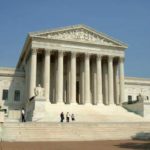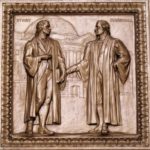Article III establishes the judicial branch of government, which is responsible for interpreting the laws. At the highest level, the judicial branch is led by the U.S. Supreme Court, which today consists of nine justices. In the federal system, the lower courts consist of the courts of appeals and the district courts. Learn more about judicial independence and judicial review in the National Constitution Center’s learning module.
What is the Judicial Branch?
This lesson exposes students to the judicial branch and the power of judicial review. They will read about an actual Supreme Court case, Torcaso v. Watkins, to see how the judicial branch used its power of judicial review to strike down an unconstitutional state law.
What Makes a Good Judge?
This lesson focuses on the costs and benefits of various judicial selection methods. Students will list characteristics they think essential or valuable to being a good judge, and then see which system of judicial selection – appointment, merit, or election – obtains the highest quality judges. In discussing each method, students will understand the tradeoffs between accountability and independence in judicial selection.
Distance Learning: Civics for Civic Engagement in the Federal Courts
Distance learning activities become civics for civic engagement when federal judges bring the rule of law, separation of powers, judicial independence, and jury service into students’ daily life. Student voice is incorporated into every activity. Teachers and students can explore the pillars of literacy: rule of law, separation of powers, and judicial independence. With the guidance of federal judges and attorney volunteers in virtual court hearings, students learn and practice civil discourse skills as the foundation of effective dispute resolution in the law and in life.
Congress and the Separation of Powers – Virtual Exhibit
Why does the U.S. Constitution separate the government into three branches? At the nation’s founding, the Constitution’s framers understood that executive, legislative, and judicial responsibilities differed, and they provided for these distinct functions. They also believed that concentrating authority in one body would result in tyranny. They therefore divided the government into legislative, executive, and judicial branches, so that no single part would become too strong, and empowered each to limit or “check” the powers of the others. This exhibit examines Congress’s unique role and the ways in which it can balance or dynamically shape and challenge the powers of two other branches.
Starter Kit: Checks and Balances Podcast
We exist in a delicate balance. Ours is a system designed to counterweight itself, to stave off the power grabs that entice even the fairest of us all. The U.S. government is comprised of humans, not angels, so each branch has the power to stop the other from going to far. The only catch being, of course, they have to actually exercise that power. In this episode, with the inimitable Kim Wehle as our guide, we learn what those checks actually are, and how the Executive, Legislative and Judicial branches (ostensibly) keep things democratic.
This short episode includes a one-page Graphic Organizer for students to take notes on while listening, as well as discussion questions on the back side.
Judicial Appointments under the United States Constitution
Explore historical sources related to judicial appointments under the United States Constitution. A great resource to use during Supreme Court nomination debates to illustrate the original conflicts over the court and contextualize contemporary issues.
The Supreme Court: The Judicial Power of the United States

This lesson provides an introduction to the Supreme Court. Students will learn basic facts about the Supreme Court by examining the United States Constitution and one of the landmark cases decided by that court. The lesson is designed to help students understand how the Supreme Court operates.
The federal judiciary, which includes the Supreme Court as well as the district and circuit courts, is one of three branches of the federal government. The judiciary has played a key role in American history and remains a powerful voice in resolving contemporary controversies. The first governing document of this nation, the Articles of Confederation, gave Congress certain judicial powers, but did not establish a distinct federal court system.
John Marshall, Marbury v. Madison and Judicial Review—How the Court Became Supreme

If James Madison was the “father” of the Constitution” John Marshall was the “father of the Supreme Court”—almost single-handedly clarifying its powers. This new lesson is designed to help students understand Marshall’s brilliant strategy in issuing his decision on Marbury v. Madison, the significance of the concept of judicial review, and the language of this watershed case.
The Appointment of Sandra Day O’Connor
The U.S. Constitution grants the President the power to appoint people to a variety of government positions. These appointments require careful thought and consideration since the people can have a great impact on the lives of many Americans during that President’s term. Some appointments need even greater thought and consideration, and those are to the federal judicial system and more importantly, to the Supreme Court of the United States. Justices of the Supreme Court (and other federal courts) serve lifetime appointments. Their rulings as they interpret the Constitution, and other situations as outlined in Article III of the Constitution, can have far-reaching effects for generations. With this awesome power to appoint comes an equally awesome responsibility to make sure that the individuals are the best people for the job. In this lesson, students will examine the appointment of Supreme Court Justice Sandra Day O’Connor, who was also the first female Justice. Students will examine the process by which a President makes the selection and the steps that lead to that person being confirmed by the Senate (or not).